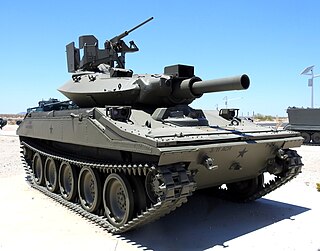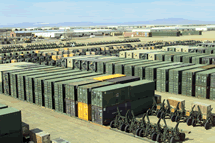
The M1 Abrams is a third-generation American main battle tank designed by Chrysler Defense and named for General Creighton Abrams. Conceived for modern armored ground warfare and now one of the heaviest tanks in service at nearly 68 short tons, it introduced several modern technologies to US armored forces, including a multifuel turbine engine, sophisticated Chobham composite armor, a computer fire control system, separate ammunition storage in a blowout compartment, and NBC protection for crew safety. Initial models of the M1 were armed with a 105 mm M68 gun, while later variants feature a license-produced Rheinmetall 120 mm L/44 designated M256.

The M551 "Sheridan" AR/AAV was a light tank developed by the United States and named after General Philip Sheridan, of American Civil War fame. It was designed to be landed by parachute and to swim across rivers. It was armed with the technically advanced but troublesome M81/M81 Modified/M81E1 152 mm gun/launcher, which fired both conventional ammunition and the MGM-51 Shillelagh guided anti-tank missile.

The Bradley Fighting Vehicle (BFV) is a tracked armored fighting vehicle of the United States developed by FMC Corporation and manufactured by BAE Systems Land & Armaments, formerly United Defense. The BFV is named after U.S. General Omar Bradley.

The MBT-70 was an American–West German joint project to develop a new main battle tank during the 1960s.

The M60 is an American second-generation main battle tank (MBT). It was officially standardized as the Tank, Combat, Full Tracked: 105-mm Gun, M60 in March 1959. Although developed from the M48 Patton, the M60 tank series was never officially christened as a Patton tank. The US Army considered it a "product-improved descendant" of the Patton tank's design. The design similarities are evident comparing the original version of the M60 and the M48A2. It has been sometimes informally grouped as a member of the Patton tank family. The United States fully committed to the MBT doctrine in 1963, when the Marine Corps retired the last (M103) heavy tank battalion. The M60 tank series became America's primary main battle tank during the Cold War, reaching a production total of 15,000 M60s. Hull production ended in 1983, but 5,400 older models were converted to the M60A3 variant ending in 1990.

Before the Apollo 11 Moon landing in 1969, NASA began studies of Space Shuttle designs as early as October 1968. The early studies were denoted "Phase A", and in June 1970, "Phase B", which were more detailed and specific. The primary intended use of the Space Shuttle was supporting the future space station, ferrying a minimum crew of four and about 20,000 pounds (9,100 kg) of cargo, and being able to be rapidly turned around for future flights.
The Arab Organization for Industrialization (AOI) is an Egypt-based Arab military organization established in 1975 by Egypt, Saudi Arabia, United Arab Emirates and Qatar to supervise the collective development of the Arab defense industry. Following a gradual deterioration in relations between the AOI member-states, Egypt became sole owner of AOI in 1993. As well as meeting the requirements of the Egyptian military, AOI directs spare capacity to civilian programmes, including civilian transport and sanitation equipment; additionally, AOI has stated its intention of entering the wind power sector.
The General Dynamics Land Systems (GDLS) M60-2000 or 120S was an upgrade of the M60 tank. The development of the M60-2000 was initiated primarily due to the large number of M60 main battle tanks in service with many Middle Eastern nations unable to afford a sufficient force of more modern main battle tanks. The upgrade was marketed at those M60 users with the industrial capability to convert the tanks themselves. The M60-2000/120S was a GDLS supplied conversion kit that married the turret of the M1A1 variant of the M1 Abrams to the M60A1 hull of the M60, offering many features of the M1A1 Abrams to existing M60 users at a reduced cost.

Blue force tracking is a United States military term for a GPS-enabled capability that provides military commanders and forces with location information about friendly military forces. In NATO military symbology, blue typically denotes friendly forces. The capability provides a common picture of the location of friendly forces and therefore is referred to as the blue force tracker. When all capitalized, the term refers to a specific defense contractors' system, but the capability is found in many military and civilian mobile apps.
The following is a partial accounting of financial costs of the 2003 Iraq War by the United States and the United Kingdom, the two largest non-Iraqi participants of the multinational force in Iraq.

The Ground Combat Vehicle (GCV) was a program initiated by the United States Army in 2009, with the goal of developing a next-generation armored fighting vehicle. The first variant of the GCV to be developed would be an infantry fighting vehicle to replace the M2 Bradley.
The M1 Abrams main battle tank has been in service since 1980. Since then, it has gone through dozens of upgrades and been the baseline variant of several vehicles.

The Joint Systems Manufacturing Center, also known as the Lima Army Tank Plant (LATP) is a tank plant located in Lima, Ohio. It is a government-owned, contractor-operated facility currently operated by General Dynamics Land Systems. Workers at the plant are represented by UAW Local 2075.

The United States has produced tanks since their inception in World War I, up until the present day. While there were several American experiments in tank design, the first American tanks to see service were copies of French light tanks and a joint heavy tank design with the United Kingdom.

Sierra Army Depot (SIAD) is a United States Army post and military equipment storage facility located near the unincorporated community of Herlong, California. It was built in 1942 as one of several ammunition storage facilities located far enough inland to be safe from Japanese attack, yet close enough to western military posts and ports to facilitate shipment of supplies. The site also met the requirement that the depot be in a dry and isolated area.

The Armored Multi-Purpose Vehicle (AMPV) is a U.S. Army program to replace the M113 armored personnel carrier and family of vehicles. AMPV is a sub-project of the Next Generation Combat Vehicle program.
The defense industry of Israel is a strategically important sector and a large employer, as well as a major supplier of the Israel Defense Forces. The country is one of the world's major exporters of military equipment, accounting for 10% of the world total in 2007. Three Israeli companies were listed on the 2017 Stockholm International Peace Research Institute index of the world's top 100 arms-producing and military service companies: Elbit Systems, Israel Aerospace Industries and RAFAEL. The Defense industry in Israel is a strategically important sector and a large employer within the country. It is also a major player in the global arms market and is the 6th largest arms exporter in the world as of 2014. Total arms transfer agreements topped $12.9 billion between 2004 and 2011. There are over 150 active defense companies based in the country with combined revenues of more than $3.5 billion annually. Israeli defense equipment exports reached $7 billion in 2012, making it a 20 percent increase from the amount of defense-related exports in 2011. With the war in Ukraine, arms exports reached $12.5 billion in 2022. Much of the exports are sold to the United States and Europe. Other major regions that purchase Israeli defense equipment include Southeast Asia and Latin America. India is also major country for Israeli arms exports and has remained Israel's largest arms market in the world.
M60 tank non US-operators are the non U.S. nations that operate or used the M60 Main Battle Tank. The M60 tank entered service with the U.S. military in 1960 and served until 1991 and as a training aid until 2005. During this time it was the primary tank of the U.S.Army and U.S. Marine Corps.

The M1074 Joint Assault Bridge System is an American armored military engineering vehicle based on the Abrams M1A1 main battle tank chassis. The M1074 was designed by Leonardo DRS for the U.S. Army and Marine Corps to provide deployable bridge capability for units engaged in military operations.
The Armoured Production and Repair Factory or Military Factory 200 or Abu Zaabal Factory is an Egyptian government joint-stock company, one of the companies of the National Authority for Military Production, affiliated with the Ministry of Military Production. It was established in 1987 in the Abu Zaabal area of Qalyubia Governorate on an area of 2.5 million square metres, as a result of the agreement concluded between the Egyptian government and the United States government for the joint production of the American M1A1 Abrams main battle tank, where the first tank was produced at the factory in 1992, and the factory continued production until it produced more than 1,000 tanks of this type for the Egyptian Armed Forces.












